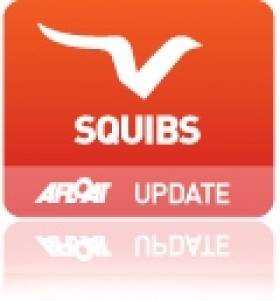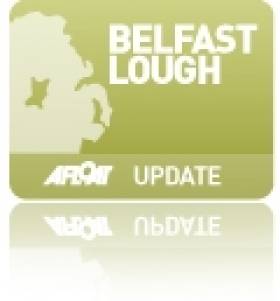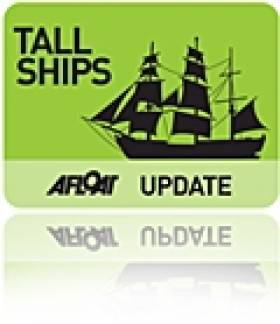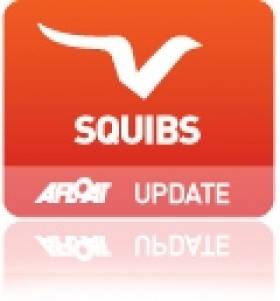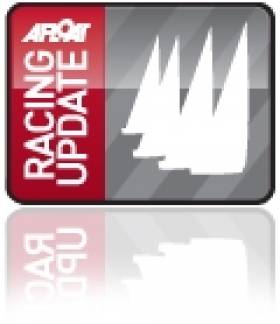Displaying items by tag: Belfast Lough
Ballyholme Prepares for Belfast Lough Laser Nationals
#laser – Next week will see one of the most competitive sailing events seen in Northern Ireland for several years as the Olympic Laser class hosts its Irish Championships on Belfast lough.
This summer has seen the best Laser Radial sailors from Ireland including many well know faces from Bangor compete across Europe. Séafra Guilfoyle from Cork won the Silver medal at the ISAF Youth World Championships in Portugal where Sarah Eames also competed. Seafra and 6 members from Ballyholme YC also competed at the World Youth Championships in Poland where Seafra came 7th. BYC's Ryan Glynn has just returned from the UK Laser Radial Nationals at Largs, Scotland with 4th place. Brother (and last year's Topper World Champion) Liam Glynn was 5th (2nd Youth), Tim Brow was 7th while Laura Gilmore from SLYC was 1st Youth Lady in a fleet of 86 boats.
Ballyholme Yacht Club will host the Zhik Irish Laser National Championships from 28 - 31st August 2014 - all of the RYANI and ISA youth squads should be in attendance for the Radial championship and a number of the GB squad will also be competing. BYC has one of the largest Laser fleets in Ireland with over 50 regularly competing in club racing and their Icebreaker series over the winter. The 2013 Irish Laser Nationals had over 120 entries. Event Organiser Paddy Brow and Race Officer Robin Gray will ensure a great series of racing and socialising off the water.
The Laser is the most popular single handed dinghy in the world and an Olympic dinghy. There are 3 fleets - Standard, Radial and 4.7 - which use the same boat but have different sail sizes for different size and weight of crew. The Standard is a men's Olympic dinghy - James Espey from Ballyholme YC represented Ireland at London 2012 - and the Radial is the female Olympic dinghy - Annalise Murphy from National YC came 4th at the London Olympics. The 4.7 is a major youth pathway dinghy worldwide.
Today (Wednesday 20th) is the last day for Early Entry Discount and Online Registration.
Squib Nationals Won By Vaughan Cousins on Belfast Lough
#squib – Cousins Ross and Andrew Vaughan, in 'Joint Venture', have secured the Rodgers & Browne Squib Irish Championship in mixed weather conditions at Royal North of Ireland Yacht Club at the weekend.
Supported by North Down Borough Council, the event attracted 24 boats from all over the island of Ireland. A strong local Royal North contingent was boosted by visitors from Howth, Dun Laoghaire and strong representation from Killyleagh Yacht Club and the Quoile.
Day one brought perfect sailing conditions – bright sunshine and 10-12 knots of breeze - which made for exciting, close racing and a bar full of smiling sailors when they all returned ashore. The first raced ended with a near photo finish. 'Joint Venture' (RNIYC) won by inches from 'Inshallah' (David Eccles/Phil Hutchinson, RNIYC) and 'Quickstep III' (Gordon Patterson/Ross Nolan, RNIYC). In Race 2, 'Inshallagh' secured first place and the third race was won by 'Perfection' crewed by Jill Fleming and Conor O'Leary from the RSGYC. After three races 'Aficionado' crewed by John Driscoll and David Cagney (RNIYC) were topping the leader board by one point from 'Joint Venture', followed by 'Quickstep III' in third place.
However, the tail end of hurricane Bertha made its presence felt on Sunday and the sun was replaced with continuous rain and a stiff breeze. Smiling faces were hard to find as sailors left the warmth of the club house to head out to the moorings for the scheduled three races. The north easterly wind direction meant that the race area was close to the moorings and racing got underway after a short postponement as a result of a slightly shifting breeze.
The conditions suited the Vaughans and they got line honours in all three of the day's races with 'Aficionado' clocking in three second places. 'The Worm' (Sam Lyness/Eric Hayes, RNIYC), 'Quickstep III' and 'Kerfuffle' (Jonathan Craig/Hazel Ruane, Howth YC) secured third place in races four, five and six respectively.
This left the Vaughans four points ahead of 'Aficionado' overnight and 'Quickstep III' in third place. However, the Vaughans' 10 point discard coupled with John Driscoll and David Cagney's consistent scoring meant that the race for the Championship was far from over. Race seven was certainly shaping up to be an interesting one...
Monday morning dawned bright but very breezy with a number of boats deciding not to race. 'Inshallah' led the race at the first windward mark with 'Joint Venture' and 'Aficionado' in hot pursuit. However by the next lap, 'Joint Venture' had managed to pull out into the lead. However, in the end it was 'Aficionado' that crossed the line first with 'Joint Venture' second and 'Quickstep III' in third. Second place was enough to secure the Championship for the Vaughan cousins in 'Joint Venture'.
The Squib Class will now focus its attention on the Inland Championship in Lough Derg in October.
Bangor Lifeboat Saves Children From Inflatable Raft
#RNLI - Bangor RNLI launched on Wednesday evening (30 July) to rescue five children who were being swept out to sea on an inflatable raft.
Belfast Coastguard requested the Bangor lifeboat to proceed at utmost speed to the shore at Whiteabbey, on the northern coastline of Belfast Lough.
Initial reports indicate that five children were aboard an inflatable raft and were being swept out to sea by the offshore winds.
At 7pm, within minutes of receiving the rescue alert, the volunteer crew had launched the lifeboat and were proceeding at full speed towards Whiteabbey.
The raft was quickly found with three children on board. Two others were found clinging to windsurfing boards alongside.
All five cold and exhausted children were rescued by the crew of RNLI Bangor lifeboat and were brought ashore at Carrickfergus Harbour into the safe care of waiting coastguards.
John Bell, volunteer RNLI helmsman who was involved in this rescue, said: "Inflatable boats and toys are great fun in the swimming pool but we do not recommend that people use them at the seaside because, as we've seen today, they can easily be blown out to sea.
"If you do find yourself in the situation where you or your child is being swept out to sea, stay in the boat shout for help and wave your arms. Do not attempt to swim for shore and if you're on the shore don't try and rescue them yourself – call 999 and ask for the coastguard."
Royal Navy Warship HMS Duncan Visits Belfast
#BelfastLough - The Belfast Telegraph reports on the weekend visit to Belfast Lough paid by the Royal Navy's latest warship HMS Duncan.
Along with Dundee in eastern Scotland, Belfast is an adoptive city of the 152m-long vessel, which docked at quayside in Belfast yesterday (Sunday 27 July) after sailing up Belfast Lough on Friday to conduct a number of official engagements.
The Belfast Telegraph has much more HERE.
Belfast Secures Support For Tall Ships Return Next Summer
#TallShips - It's confirmed: Belfast will host the start of 2015's international Tall Ships Races.
According to BBC News, the tall ships will return to Belfast Lough for the first time since 2009 to coincide with next July's Titanic Maritime Festival.
The news follows more than two-and-a-half years from the original announcement by Belfast City Council, which has since secured sponsorship for its hosting of the event from German supermarket chain Lidl.
The tall-masted fleet's return to Irish shores will come three years after Dublin hosted the Tall Ships Races Festival.
BBC News has more on the story HERE.
#squib – In August, the Squib Class will be returning to the southern shores of Belfast Lough and the Royal North of Ireland Yacht Club.
The Rodgers & Browne Squib Irish Championship, supported by North Down Borough Council, will be held over the 9th- 11th August and will attract Squibs from throughout Ireland to compete for the national trophy.
The Squib Class is one of the largest one design keelboat classes in Ireland. It is sailed by two people and is well known for its distinctive brown sails. Over the last decade fleets have flourished at Killyleagh Yacht Club, Quoile Yacht Club, Royal St George Yacht Club (Dublin) and Kinsale Yacht Club, in addition to the traditional strongholds of Cultra and Howth Yacht Club.
The reigning champion pairing of James and Bruce Matthews from Kinsale Yacht Club will battle with past winners and recently crowned Eastern Champions, John Driscoll/David Cagney, and Northern Champions, David Eccles/Michael Wright, all of whom are in contention for the main prize.
Thomas Anderson, Commodore of the Royal North commented "I am delighted to welcome the Squib Irish Championship back to Cultra. This has only been possible with the ongoing support of Rodgers & Browne and North Down Borough Council. The Squib Class has been the backbone of our Club for several decades and it is fantastic that the fleet will be showcased through this event. In addition to the excellent sailing waters of Belfast
Lough, the Club's well known hospitality will ensure that this event will be well worth attending".
Connor Browne, Partner at Rodgers & Browne, said "We are looking forward to collaborating again with the Royal North of Ireland Yacht Club and the Squib Class to bring the Irish Championship to Cultra. North Down is a stunning location for many sporting activities, which is reflected in the demand for housing within the greater Holywood, Helen's Bay and North Down areas."
#f18 - After the heroics of the last two days, the crews of the F18 breathed a sigh of relief when they woke up. Day 4 of the F18 World Championship at Ballyholme Yacht Club, Northern Ireland offered light winds and sunshine and the Race Committee managed to squeeze in three races before the wind died.
In the first race of the day (Race 10), Lois Breeder/Hugo Pomellac and Robert Solune/Riwan Perron showed that the French Junior teams also have plenty of boat speed, with the American Junior team of Taylor Reiss and Matthew Whitehead coming in third.
After swapping hulls over night with the damage yesterday, Glenn Ashby and Brett Goodall returned to form in the second race (Race 11) winning in front of France's Thomas Normand and Antoine Jalbert. Tim and Jean Christophe Mourniac came in third and also again in the last race of the day, moving up to 5th overall.
Normand/Jalbert were a little too keen to repeat their new-found success and were the only boat OCS in Race 12. Emeric Dary and David Fanouillere came in second instead, but it was Gunnar Larsen and Ferdinand van West who lead the way home and moved into first place overall.
For others, the dying wind proved a little tricky and English crew Ben Lodge and Niall McLoughlin decided to park on one of the gate marks, hulls either side, while the rest of the fleet sailed past.
The F18 World Championship comes to a climax tomorrow with 3 more races scheduled and light winds forecast again. With only 10 points separating the top 3, everything is still up for grabs.
1. Gunnar Larsen and Ferdinand van West NED 38pts
2. Taylor Reiss and Matthew Whitehead (Junior) USA 42pts
3. Gurvan Bontemps and Benjamin Amiot (FRA) 49pts
4. Morgan La Graviere and Armaud Jarlegan (FRA) 78pts
5. Tim and Jean Christophe Mourniac (FRA) 81pts
6. Robert Solune and Riwan Perron (Junior) FRA 89pts
Commissioners of Irish Lights Chart First Permanent Virtual Aid to Navigation in Irish Waters
#lighthouses – The Commissioners of Irish Lights (CIL) has the first permanent Virtual Aid to Navigation charted in Irish Waters on the 5th June 2014. The port hand Virtual Aid to Navigation was established at the entrance to Belfast Lough on the North East Coast of Ireland. This was in response to a newly reported shoal depth of 8.0 metres at the Rigg Bank.
CIL explored various options to ensure the shoal depth was addressed correctly. One option was to place a buoy to mark the pinnacle depth. However, after completing a Risk Assessment and extensive Automatic Identification System (AIS) analysis, it was clear the buoy would introduce a new danger in the relatively deep water. As a result, the port hand Virtual Aid to Navigation was chosen and deployed approximately half a nautical mile east of the position of the new pinnacle depth on the 20th November 2013.
Deirdre Lane, Navigation Policy Officer in CIL commented "It was found that deep draft vessels which need to have the pinnacle depth highlighted the most, are those that have the capability for a Virtual Aid to Navigation to be displayed on their on-board systems. In this unique set of circumstances, it was clear the Virtual Aid to Navigation was the best option".
One of the functionalities of AIS is that a land based AIS station can be used to transmit the position of an AIS Aid to Navigation that does not physically exist in the water. It is represented as a digital symbol on the ships Radar, Electronic Display and Information System (ECDIS) or Integrated Navigation System.
In order to bring the Virtual Aid to Navigation to the Mariners attention, it was officially mapped on navigational charts by the UKHO at CIL's request on 5th June 2014. As a result, CIL is responsible for the first permanent charted Virtual AIS Aid to Navigation in Irish waters.
#f18worlds – Ballyholme Yacht Club woke up to champagne conditions on Day 1 of the 55–boat F18 World Championship this morning. As the fleet took to the water, however, the wind began to drop and swing around, providing a challenge for the race committee.
Full results downloadable below.
A couple of attempted starts had to be postponed as the wind swung around. The Committee boat moved positions several times as local winds filled in from different directions. After a delay of 3 hours and a general recall, the race finally got underway with a black flag to keep the eager competitors away from the line. The Argeninian crew Ian Rodger and Pablo Volker got squeezed at the starboard (right hand) end of the line almost colliding with the committee boat.
It was the French son and father team of Tim and Jean Christophe Mourniac who managed to work their way up to the windward mark first followed by fellow countrymen Morgan La Graviere and Arnaud Jarlegan. Jean Christophe is a long time professional catamaran sailor but had given the helm this week to his son. Close behind were the Dutch team of Gunnar Larson and Ferdinand van West followed by Australia's Glenn Ashby and Brett Goodall. Local crew Adrian Allen and Barry Swanston rounded in a very credible 6th position but struggled in the second downwind leg in light and patchy conditions to finish 40th. The top teams had their problems as well and the second round saw the fight for first place with Larsen/ van West taking pole position into the second windward mark, followed closely by Ashby/Goodall.
The breeze started to die as they made their way into the finish but Larson/Van West held their first place through the line, followed by Ashby/Goodall in second and the German team of Helge and Christian Sachs in third.
The Committee boat tried to squeeze in the second of three races scheduled as the wind started to fill in. A 30 degree windshift however persuaded them to abandon racing for the day. Hopefully we will have steadier breezes tomorrow.
The first start is scheduled for 11:30 tomorrow with 3 races planned. The public are invited to come down to Bangor and watch the racing.
#carrickfergus – Carrickfergus Sailing Club on Belfast lough is celebrating the re-opening of its newly restored clubhouse just two years after a major fire destroyed the building.
VIPs and members of the sailing fraternity from across Northern Ireland gathered at Rodgers Quay for the Grand Opening and to sample the impressive new facilities that will make Carrickfergus one of the top sailing clubs in Ireland.
The new clubhouse was opened by Terry Windsor, who is one of the best known members of the club, having joined in 1955. He is also one of the most experienced sailors and for the last five years has been Race Officer for the Clubs Points Racing.
Members of the club have worked hard over the past two years to ensure that sailing continued as normal and events went ahead despite the devastating loss of their clubhouse.
Up to seven fire appliances were called to the clubhouse at Rodgers Quay on June 23, 2012 as a major blaze swept through the building. The next morning, club members met to begin drawing up a Development Plan which would see the clubhouse fully restored.
The restored premises are better than ever with new state-of-the-art changing facilities fully accessible to sailors with a disability and a new multi-purpose room ideal for dinghy sailing. The clubhouse also features a large first floor balcony area with stunning views across Belfast Lough.
Club Commodore Trevor Kirkpatrick praised club members for their work in ensuring that the club's sailing calendar continued.
He said: "It has been a difficult two years but I am so delighted that we are back at the clubhouse that has been our home for the past 35 years. I would like to thank everyone in the sailing fraternity who rallied round and helped ensure this great club continued.
"We are immensely proud of this new building that is not only much more environmentally friendly but also has full disabled access. Carrickfergus is now very well placed to attract a host of major sailing events to our town."
Mr Kirkpatrick added: "After the fire we were struck by the messages of support we received from sailing clubs as far away as Dublin. Our members really rose to the challenge, volunteering for extra duties and helping to clear up after the fire.
""We would like to thank our neighbours including Carrick Sea Cadets, Belfast Lough Sailability, Carrickfergus Marina & Premier Inn for helping us out with use of their facilities during the time of restoration."
The Deputy Mayor of Carrickfergus, Councillor Lynn McClurg, who officiated at the re-launch, commented: "It gives me great pleasure to be here today representing Carrickfergus Borough Council and deputising for the Mayor,
Alderman Johnston, who sends his apologies as he has a prior engagement.
"It was actually our current Mayor, Alderman Johnston, who officially opened the Club when it was first built in 1984. Despite the tragic circumstances of the fire, the Club pulled together and with an immense fundraising effort, has managed to create this very valuable local community asset. All of those involved are to be highly commended for their endeavours and the analogy of the 'phoenix rising from the ashes' is entirely appropriate on this occasion."
Ronnie Brown, Chief Operations Officer of the Royal Yachting Association Northern Ireland, said: "We in the Royal Yachting Association Northern Ireland are aware of the huge effort which has gone into getting this project to completion and delighted that Carrickfergus Sailing Club, which has produced and continues to produce so many top class sailors, is now fully back in business in exciting new accommodation."



























